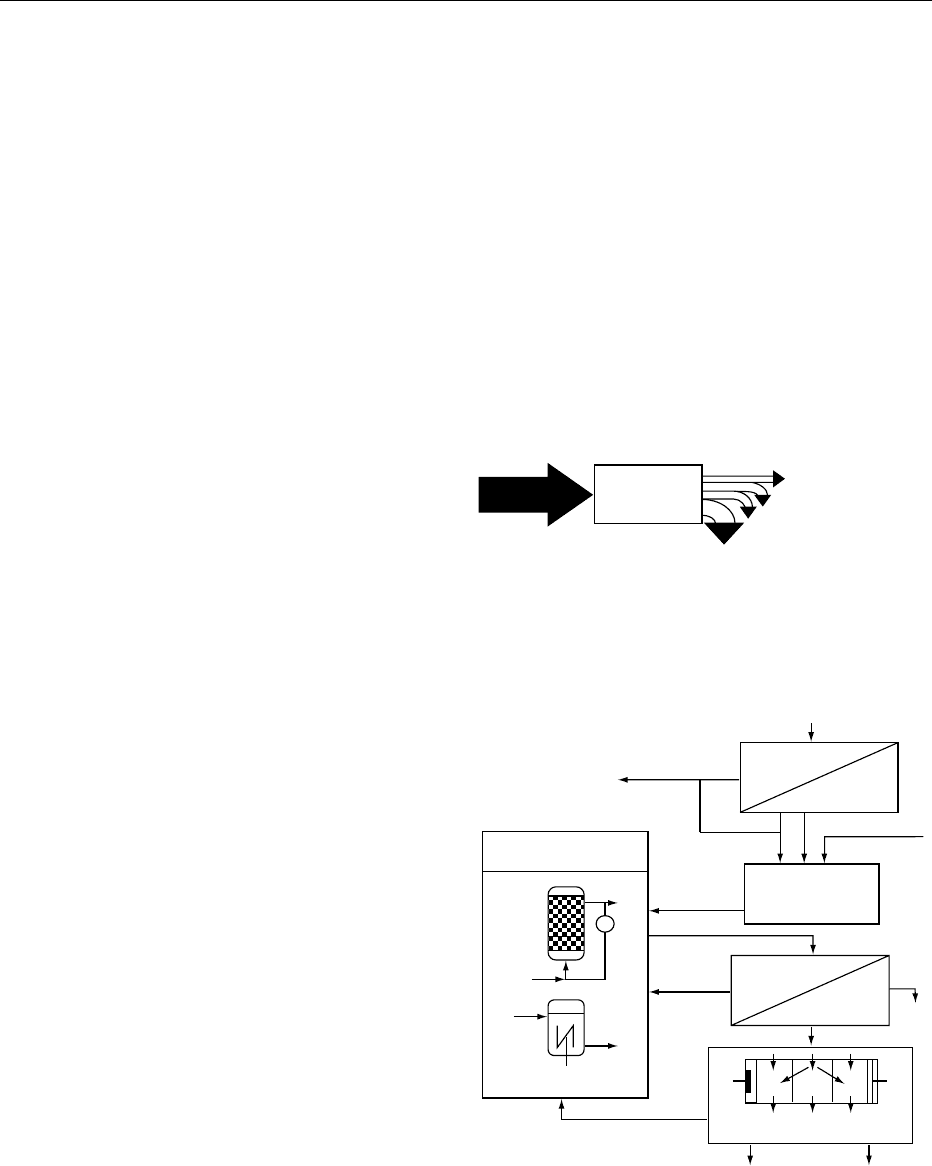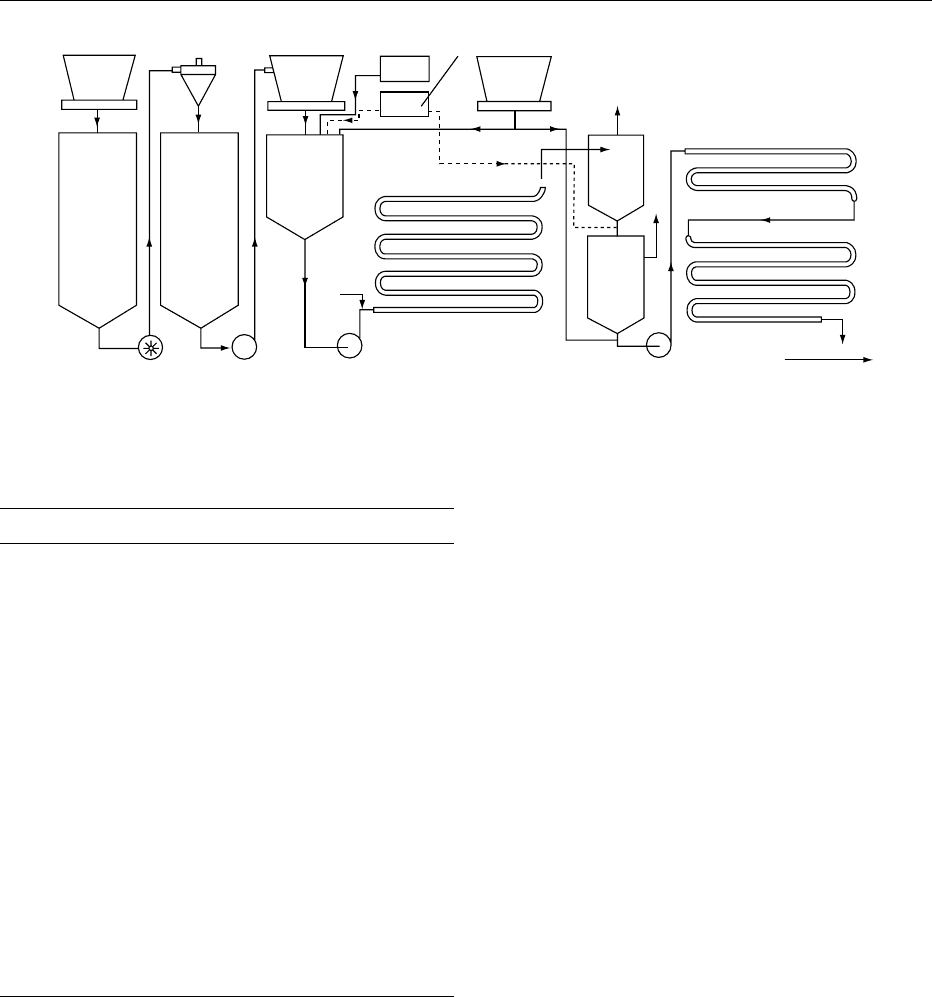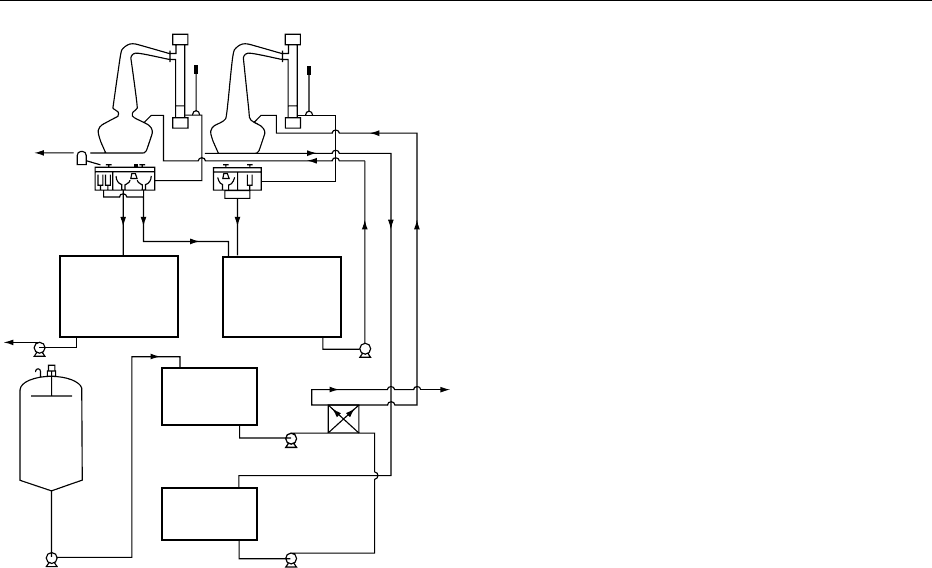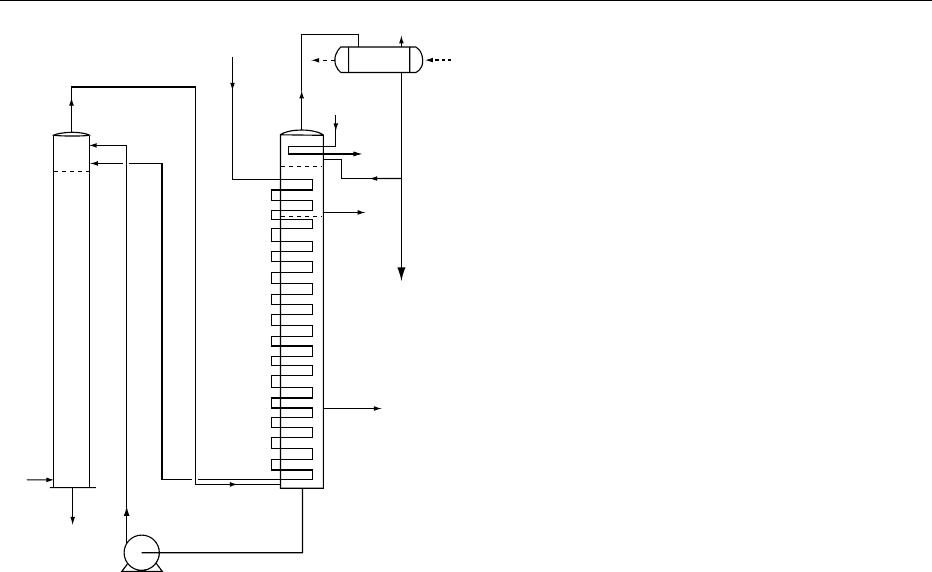Caballero B. (ed.) Encyclopaedia of Food Science, Food Technology and Nutrition. Ten-Volume Set
Подождите немного. Документ загружается.


economical point of view. The value of 90% is con-
sidered the practical limit of salt removal due to
decreasing electrical conductivity with demineraliza-
tion. ED is likely to have advantages for plants with
high hourly utilization rates, for the manufacture of
products that do not require high levels of demineral-
ization, and where low-cost electricity is available.
Based strictly on economics, the recent trend is to-
wards combined ED ion exchange plants. The major-
ity of ED plants use preconcentrated sweet whey as
well as acid whey, skimmed milk, delactosed whey,
milk, whey protein concentrate, and whey ultrafiltra-
tion (UF) permeates.
0009 Whey produced by ED has a reduced mineral con-
tent and is rich in lactose and whey proteins, and
contains appropriate low levels of essential minerals,
which makes it an ideal ingredient for infant formu-
las. Raw whey is concentrated to 23–27% solids, and
clarified before ED. Liquid or dried reduced-minerals
whey could be used for blending infant formulas, but
a high level of demineralization (90%) is required for
sweet whey to be used in an infant formula. The use
of reduced-minerals whey as an ingredient in infant
formulas must be ranked as one of the major suc-
cesses in terms of the valuable and profitable use of
a byproduct. Reduced-minerals whey could be used
in animal feeds, protein and citrus drinks, dry mixes,
confectionery coatings, icecream, and bakery goods.
0010 Although the trend has been towards the use of
whey protein-based infant formulas, there is also a
considerable percentage of infant formulas produced
in which nonfat milk is used as the sole source or
protein. These products tend to have higher ash con-
tents, including higher levels of phosphorus, calcium,
sodium, potassium, and chloride, than whey protein-
based formulas. Other ED applications include the
partial demineralization of whey protein concentrate,
which is ideal for products that require a higher pro-
tein-to-lactose ratio; acid whey for mixing with sweet
whey in the manufacture of whole whey powder; and
of cottage cheese whey in order to reduce disposal
problems.
0011 ED is also used in various integrated membrane
systems for specific purposes, e.g.:
.
0012 Nanofiltration/ED systems: nanofiltration is used
to concentrate and partially demineralize whey
prior to ED, which in turn completes demineral-
ization to the desired level.
.
0013 UF/ED systems: UF allows molecules, such as
sugars and salts, to pass through the membrane
while protein molecules are retained. UF is used
to produce whey protein concentrate (WPC) while
ED demineralizes the WPC to produce a low-ash,
high-protein ingredient for infant formulas.
Microbial Fermentation Systems
0014Membrane techniques are well established in
fermentation processes and are increasingly used in
integrated bioprocesses. Figures 2 and 3 give an indi-
cation of the possible implementation of an inte-
grated bioprocess in the dairy industry using cheese
whey/waste water as substrate for the production of
lactic acid. Regarding the fermentation of concen-
trated substrates, one application for the ED tech-
nique during upstream processing may be a partial
reduction of the salt content and to obtain osmotic
pressure to their optimum values. A final microfiltra-
tion step can be incorporated to obtain a continuous
Dairy waste water
Cells
Lactic acid
Purified waste water
Whey protein
Integrated
bioprocess
fig0002Figure 2 The recovery of lactic acid and other products of value
from whey/dairy waste water, using an integrated bioprocess
system. Courtesy of Fraunhofer Institute for Interfacial Engineer-
ing and Biotechnology, Stuttgart, Germany.
Whey
Cells
Microfiltration
Ultrafiltration
Retentate
Permeate
Medium
preparation
Additives
CSTR CR
−
+
CFBR
V
Bioreactor
Precleaned
waste water
Neutralization agent
Lactic acid
Bipolar electrodialysis
fig0003Figure 3 An integrated bioprocess for the production of lactic
acid from whey using an integration of membrane systems in
combination with a fermentation process. CSTR CR, continuous
stirred tank reactor with cell recycling; CFBR, continuous fluid-
ized-bed reactor. Courtesy of Fraunhofer Institute for Interfacial
Engineering and Biotechnology, Stuttgart, Germany.
WHEY AND WHEY POWDERS/Applications of Dialysis 6169

delivery of sterile substrate to the bioreactor. In con-
tinuous fermentation systems, membranes can be
used for cell separation, retention of metabolic com-
pounds, and recirculation. The reaction compounds
are discharged from the membrane reactor with the
permeate, which is then replaced by a new substrate
solution. Owing to cell retention, cell density and,
hence, substrate conversion velocity can be signifi-
cantly enhanced.
0015 The application of ED in downstream processing
offers many economically competitive methods for
the recovery of whey-based lactic acid:
.
0016 Continuous cell recycling with UF or microfiltra-
tion membranes followed by the removal of lactic
acid by ED units.
.
0017 Acid recovery by means of ED with bipolar mem-
branes (Figures 3 and 4). Bipolar membranes con-
sist of cation and anion exchange layers arranged in
parallel between two electrodes which enable the
lactate salt to be split and electrically neutralized by
H
þ
ions and the corresponding alkali. The function
of the bipolar membrane in the electrodialytic pro-
duction of acids and bases from the corresponding
salt solution is based on its capability for enhanced
water dissociation under the influence of an electric
potential gradient.
The combination of technologies and the demand for
specialized products will in future lead to the next
generation of highly differentiated whey protein-
based products, with specific functionalities.
Other Applications of Dialysis
001 8 Dialysis and ED techniques are also applied in the
demineralization of foods such as soy sauce, fruit
juice, vinegar, hydrolyzed vegetable protein, sugars,
and wine; deacidification of foods; purification of
fermented products, hydrolysates, lipopolysacchar-
ides, and protein fractions; as well as for the isolation
of flavor substances and the production of enzymes.
Other applications include the recovery of salts,
acids, or alkali from industrial rinse waters as well
as the purification of drinking water supplies, e.g.,
drinking water nitrate reduction.
Seealso: Cheeses:ChemistryofGelFormation;
ManufactureofExtra-hardCheeses;ManufactureofHard
andSemi-hardVarietiesofCheese; Effluents from Food
Processing:MicrobiologyofTreatmentProcesses;
DisposalofWasteWater; Infant Foods:MilkFormulas;
WeaningFoods; Membrane Techniques:Principlesof
ReverseOsmosis;ApplicationsofReverseOsmosis;
PrinciplesofUltrafiltration;ApplicationsofUltrafiltration;
Whey and Whey Powders:ProductionandUses;Protein
ConcentratesandFractions;FermentationofWhey;
PrinciplesofDialysis
Further Reading
Batchelder BT (1987) Electrodialysis applications in whey
processing. In: Trends in Whey Utilization. IDF Bulletin
no. 212, pp. 84–90. Brussels: International Dairy Feder-
ation.
Bylund G (1995) The chemistry of milk. In: Dairy Process-
ing Handbook, p. 17. Lund, Sweden: Tetra Pak (Process-
ing System Division).
Bylund G (1995) Whey processing. In: Dairy Processing
Handbook, pp. 331–351. Lund, Sweden: Tetra Pak (Pro-
cessing System Division).
Fraunhofer Institut Grenzfla
¨
chen- und Bioverfahrenstech-
nik (2001) Integrated bioprocesses – recovery of value
products from waste materials. Internet: http://
www.igb.fhg.de/UWbio/en/Lactic_acid.en.html. Ac-
cessed 6 November 2001.
Horton B (1998) The whey processing industry – into the
21st century. In: Whey, special issue 9804, pp. 12–
25.Brussels: International Dairy Federation.
Ionics (2001) Membrane systems for food and dairy
processing. Internet: http://www.ionics.com/products/
WaterFoodChemical/FoodProcessing/fooddairy.htm.
Accessed 12 January 2001.
Kulozik U (1992) Membranes in microbial fermentations.
In: New Applications of Membrane Processes. Special
issue 9201, pp. 141–160. Brussels: International Dairy
Federation.
Lo
´
pez-Leiva MH (1988) The use of electrodialysis in
food processing. Part 2: Review of practical applica-
tions. Lebens-mittel-Wissenschaft und Technologie 21:
177–182.
Mostert JF and Roberts JJ (1993) Applications of dialysis.
In: Macrae R, Robinson RK and Sadler MJ (eds)
Encyclopaedia of Food Science, Food Technology and
Nutrition, vol. 8, pp. 4905–4908. London: Academic
Press.
From the fermenter
Bipolar membrane
−
Lac NH
+
4
−
Lac
HLac
NH
4
OH
H
+
H
+
+
+
+
+
+
+
+
−
−
−
−
−
−
−
OH
−
OH
−
H
2
O
Further
purification
To the
fermenter
NH
+
4
H
+
+
+
+
+
+
+
−
−
−
−
−
−
OH
−
H
2
O
fig0004 Figure 4 Schematic diagram of the function of bipolar electro-
dialysis membrane. Reproduced from Kulozik U (1992) mem-
branes in microbial fermentations. In: New Applications of
Membrane Processes. Special issue 9201, pp. 141–160. Brussels:
International Dairy Federation, with permission.
6170 WHEY AND WHEY POWDERS/Applications of Dialysis

WHISKY, WHISKEY, AND BOURBON
Contents
Products and Manufacture
Composition and Analysis of Whisky
Products and Manufacture
J R Piggott, University of Strathclyde, Glasgow, UK
J M Conner, The Scotch Whisky Research Institute,
Riccarton, Edinburgh, UK
Copyright 2003, Elsevier Science Ltd. All Rights Reserved.
Synopsis
0001 Whiskies are distilled beverages which have been
produced by the distillation of fermented cereals and
have been matured in oak casks. They can be classi-
fied according to starting material, blending and
country of origin. The major grains used in whisky
production are maize, barley, wheat and rye. Amylase
activity required for starch breakdown is obtained
from malted barley, and some regulations permit the
use of other enzymes. The yeast used for fermentation
of the cereal extract is normally a specially developed
strain of Saccharomyces cerevisiae. Distillation is in
small pot stills or continuous column stills, followed
by maturation normally for at least 3 years in oak
casks.
Types of Product
0002 Whiskies are distilled beverages that have been pro-
duced by the distillation of fermented cereals and
have been matured in oak casks. They can be classi-
fied on the basis of the nature of the cereal, the
manner in which the product is blended, if at all,
and the country of origin. Although there is some
evidence for a distillation-type process in ancient
Egypt, the first reports of whisky production arise in
Ireland in the twelfth century, and the first description
of a whisky production process is found in Scottish
records dating from 1494. The term ‘whisky’ is
derived from the Gaelic ‘uisge beathe,’ which means
‘water of life.’ Major countries of production are
Scotland, the USA, Ireland, Canada, and Japan,
while similar products are produced in many other
countries including Brazil, Korea, and Spain.
0003 Regulations in the European Union (EU) define
whisky as a spirit produced by the distillation of a
mash of cereals and matured for at least 3 years in
wooden casks. There are limitations on the enzymes
that can be used to hydrolyze starch to fermentable
sugars and on the distillation strength, and yeast must
be used for the fermentation. Within this definition,
Scotch and Irish whiskies are further restricted. In
practice, this provides for three distinct products:
malt whisky, produced from 100% malted barley;
grain whisky, produced from unmalted cereal grains;
and the bulk of the whisky produced in Scotland,
which is blended from 60–70% grain whisky and
30–40% malt whiskies. This blended whisky usually
contains up to 40 individual malts that are blended to
produce a consistent brand flavor, and every compon-
ent of the blend must be matured for the minimum
period, or the age specified on the bottle. Malt
whiskies may contain either a blend of malt whiskies
of a given minimum age or malt whisky from a single
distillery. Scottish malts have a different character
depending upon whether they are from the west
coast, such as Campbeltown and the Islay region,
which produce highly peated malts, or from the High-
lands or the Lowlands. Irish whiskies have a similar
flavor to Scotch but do not have a peaty character.
0004Whisky produced in the USA has evolved in a
different legislative framework, allowing for a greater
variety of distinctive products. The basic definition of
US whiskey is that it is distilled from a fermented
grain mash at less than 95% alcohol (190
US
proof). Within this broad definition, there are two
special categories, which are bottled as such or
provide flavoring whiskies for blending. In the first
group, the cereal content of the mash is restricted to
not less than 51% of the named cereal (e.g., rye for
rye whiskey, maize for Bourbon), the distillation must
be at less than 80% alcohol, and maturation must be
in new charred oak. Bourbon takes its name from
Bourbon County in Kentucky. Corn whiskey must
be from a mash of 80% maize, and matured in new
uncharred or used oak. If matured for 2 or more
years, these are ‘straight whiskies.’ They are to the
blender the equivalent of the Scotch malts, and pro-
vide the majority of the flavor in a blend with lighter
flavored grain spirits. US blenders are also permitted
to use ‘blending materials,’ such as sherry or blending
wine, at up to 2.5%. (See Barrels: Wines, Spirits, and
WHISKY, WHISKEY, AND BOURBON/Products and Manufacture 6171

Other Beverages; Sherry: The Product and its Manu-
facture; Wines: Production of Table Wines.)
0005 Canadian whisky production follows the same gen-
eral practice as in Scotland and the USA. Canadian
blends are light column still whiskies with normally
10–15% of heavier-bodied flavoring whiskies. Up to
9.09% (on the basis of absolute alcohol content) of
‘flavorings’ is permitted, which may include wines
and sherries, rum, brandy, bourbon, or malt whisky.
Maturation must be for not less than 3 years, and oak
casks of 182 l (40 imperial gallons) are commonly
used. The range in flavor required by the blender
cannot be achieved by using the products of many
different distilleries, but techniques such as variation
of the composition of the mash (corn, wheat, rye or
barley), cooking procedures, yeast strain, distillation
procedure, barrel type, and maturation period can be
used. Traditionally, pot stills were used but these have
largely been phased out. (See Brandy and Cognac:
Armagnac, Brandy, and Cognac and their Manufac-
ture; Rum.)
0006 Similar products are produced in many other coun-
tries and are subject to local regulations, which, while
generally similar in principle to the EU definition,
allow different extents of variation. In Brazil, regula-
tions permit the addition of a proportion of agricul-
tural alcohol to blended whisky, and in Japan, the
locally produced spirit is frequently blended with
imported Scottish malts. Spain is a substantial produ-
cer of whisky, which must meet the EU requirements.
EU and USA regulations also include provision for
grain spirits or grain brandies, which are essentially
similar to whiskies but not matured. In other parts of
Europe (e.g., Poland), ‘whiskies’ are produced that
are essentially vodkas, matured briefly and flavored
with wood extracts or other materials, and which
may or may not meet regulations commonly accepted
for whiskies.
Raw Materials
0007 The major grains used in whisky production are
maize (Zea mays), barley (Hordeum polysticum),
wheat (Triticum vulgare), and rye (Secale monta-
num). These are the grains traditionally used for
whisky, on the basis of a high fermentable starch
content providing a good yield of alcohol. A typical
composition of these grains is shown in Table 1.
In Scotland and Ireland, all the amylase activity re-
quired for starch breakdown is obtained from malted
barley, in the form of either a kilned malt, which is
stored at a moisture content of 5%, or a green malt,
which is prepared specifically on site as a source of
enzyme activity for production of grain whisky. Some
regulations also permit the use of other (normally
microbial) enzymes during wort production. Culti-
vars are normally selected on the basis of extract
and fermentability, corresponding to spirit yield, or
enzyme activity in the case of malt for grain distilling.
Enzyme activity should be considered under process
conditions, as this will not be the same as activity
measured under optimum laboratory conditions.
Ethyl carbamate is an undesirable trace component
in distilled beverages, and its content in malt whisky
is largely determined by the cyanogenic precursor,
epi-heterodendrin, in malt. Barley cultivars that do
not contain the precursor are being developed. (See
Barley; Rye; Wheat: Grain Structure of Wheat and
Wheat-based Products.)
0008Water is required for mashing, cooling during dis-
tillation, dilution of the spirit before maturation, and
blending. The quality of the product may be influ-
enced by the nature of the water supplied, and many
distilleries take their water supply from individual
water courses or special wells. Soft water is normally
used for malt distilleries, but some degree of hardness
is preferred in grain distilleries since this has a stabil-
izing effect on the amylase enzymes. The water should
be monitored for chemical and microbiological
contamination and be free of decaying vegetable
matter. The water used for dilution of the spirit must
have a low calcium and iron content, and is normally
demineralized, to minimize the risk of discoloration
or precipitation occurring in the final product.
0009The yeast used for fermentation is normally a spe-
cially grown distilling yeast that has good physio-
logical and microbiological properties for producing
alcohol. However, some recycled brewer’s yeast is
commonly used in Scotland, and yeasts from previous
distillery fermentations may be used in some Bourbon
tbl0001Table 1 Composition of cereals used in the production of
whisky worts
Corn Rye Barley Wheat
Percentage of total
Endosperm 82 87 84 85
Germ 12 3 3 3
Bran 6 10 13 12
Chemical composition (%, dry-weight basis)
Nitrogen-free extract 69.2 70.9 66.6 69.9
Starch 72 68 63–65 69
Sugars 2.6 0 2–3 0
Protein 8 12.6 12 13.2
Soluble nitrogen (% of total) 4.7 0 11 0
Crude fiber 2 2.4 5.4 2.6
Fat 3.9 1.7 1.9 1.9
Ash 1.2 1.1 2 1.9
From Bronsky AJ and Schumann RW (1989) Cereals for whisky production.
In: Piggott JR, Sharpe R and Duncan REB (eds) The Science and Technology
of Whiskies, pp. 1–18. Harlow, UK: Longman Scientific and Technical, with
permission.
6172 WHISKY, WHISKEY, AND BOURBON/Products and Manufacture

processes, which may influence the range of flavor
products in the wash. The main criterion for yeast
strain selection is normally efficiency in converting
fermentable sugars to ethanol. To a limited extent,
strains may be selected to provide the required com-
position and flavor characteristics in the distillate,
particularly the ester content, and yeast cultivation
and storage conditions also affect its performance.
Yeasts expressing glucoamylase activity have been
developed.
0010 Barrels used in whisky production are produced
from either American white oak, Quercus alba and
related species, or the Spanish oak, Quercus robur.
Scotch whisky is traditionally matured in barrels
which have previously been used for Bourbon matur-
ation or sherry production. Spanish sherry produc-
tion is carried out in barrels constructed from either
Spanish or American white oak. Except where the
regulations provide otherwise, barrels are commonly
reused until they fail to provide a satisfactory matur-
ation. Such barrels may be regenerated by scraping
out the inner surface and charring the inside of the
barrel, but this does not produce performance equiva-
lent to a new barrel. During periods when sherry
casks have been in short supply, barrels have also
been wine treated or wine seasoned (filled with sherry
for up to 6 months), and Madeira or port casks are
also occasionally used. (See Barrels: Beer Making;
Sherry: The Product and its Manufacture.)
Method of Manufacture
Malting and Mashing
0011 The traditional method of production involves the
production of wort from cereal grains using amylases
from barley. These a- and b-amylases are produced by
the barley during the malting process. Malting of
barley is carried out by steeping the grain in water
for 2–3 days and permitting the grain to germinate
until the root is approximately one-third the length of
the grain. When this stage is reached, the grain is
dried down to a moisture level of 5% by kilning.
The grain is then stored until immediately prior to
use, when it is milled before being transferred to a
mash tun. In Scotch whisky production, peated malt
is prepared by drying the malt in the presence of
smoke from a peat fire and is an important source
of flavor compounds, normally assessed on the
basis of the total phenols content of the malt (up to
50 p.p.m.), although other components may contrib-
ute to flavor. The nitrosamine contamination of malt
has recently been of concern in Scotch whisky, arising
from the use of natural gas in directly fired kilns. This
can be controlled by the use of burners designed to
reduce nitrogen oxides, by burning sulfur to add
sulfur dioxide to the air stream, or by indirect firing.
(See Flavor (Flavour) Compounds: Structures and
Characteristics; Phenolic Compounds.)
0012Most of the breakdown of the starch occurs during
the process of mashing, which is carried out in a mash
tun. Barley grist can be mashed directly since it has a
high amylase activity, whereas worts produced from
maize and other cereals require the addition of malted
barley as a source of enzymes. The process of mashing
may be a simple batch process similar to the infusion
mashing techniques used in brewing beer, in which
the grist is mixed with water at 63–68
C for 0.5–
1.5 h before the wort is filtered off. However, in the
production of grain whisky, an initial cooking stage,
to gelatinize the starch of the nonbarley cereals, is
required. The cooking may be carried out as a batch
process at 120
C for 1.5 h or, as is more usual in
North America, as a continuous process. In either
case, the mash is cooled to 60–65
C before the add-
ition of the malted barley. Careful control is required
at this stage to prevent the solidification of the gelat-
inized starch. When a cooking stage is used, amylase
activity is normally provided by adding 10–15%
freshly malted barley (green malt) after the cooking
stage (Figure 1). (See Starch: Structure, Properties,
and Determination.)
0013During the malting stage, b-glucanase enzymes are
also produced; these facilitate the breakdown of the
endosperm cell walls and the release of starch and
proteases. The latter are involved in the breakdown of
some of the barley grain proteins to amino acids and
peptides. These amino acids are an essential nitrogen
source for the growth of the yeast. (See Amino Acids:
Properties and Occurrence; Peptides.)
0014The mash is usually filtered prior to the fermenta-
tion to give a clear wort, but in some processes, a
higher yield is obtained by fermenting the whole mash
directly. The composition of a typical Scotch grain
whisky wort is shown in Table 2. Refer to individual
ingredients.
Fermentation
0015The wort, which is produced when the contents of the
mash tun has been filtered, is then transferred to a
fermentation vessel and fermented using one or more
strains of the yeast Saccharomyces cerevisiae to give
a wash containing approximately 7% ethanol and a
large number of flavor compounds. When the wort is
not boiled (as is the case in malt whisky production),
it contains microorganisms and active amylases. It is
cooled to 20–25
C before inoculation with a strain of
distilling yeast and, in some processes, secondary
yeasts. Yeast growth occurs rapidly and is completed
in the first 8–12 h. Ethanol production follows
WHISKY, WHISKEY, AND BOURBON/Products and Manufacture 6173

growth initially, then continues in a linear manner
until the metabolizable sugars have been consumed.
During the growth period, wort sugars are rapidly
metabolized, and the temperature may rise to 33
C
if it is not controlled. The pH drops from an initial
value of 5.0–5.5 to 4.2–4.5 as a result of the produc-
tion of organic acids, such as acetate, succinate, and
pyruvate. A wide range of flavor compounds, such as
higher alcohols, fatty acids, esters, and carbonyl com-
pounds, are also produced throughout the fermenta-
tion; they pass through into the distillate and
constitute an important part of the product. In con-
trast, glycerol, which is also produced, is nonvolatile
and does not pass into the distillate; this represents an
important loss of yield. At the end of the fermenta-
tion, usually between 48 and 72 h, death and auto-
lysis of the yeast may occur. The fermentation is not a
sterile process, so bacterial contamination can occur.
Most of the bacteria that are introduced from the raw
materials die during the early stages of the fermenta-
tion. However, lactobacilli can survive and grow with
a concurrent formation of lactic acid during the later
stages of the fermentation. There is some suggestion
that limited growth of lactic acid bacteria is beneficial
in flavor terms, but to prevent excessive growth and
resulting yield losses, fermentation is normally com-
pleted in 40–48 h, rather than the longer times trad-
itionally used. Heavy contamination by lactic acid
bacteria can also result in a loss of yield and the pro-
duction of acrid off-flavors. (See Lactic Acid Bacteria.)
Distillation
0016The fermented wash is then distilled either in a series
of two or three pot stills (Figure 2), or in a series of
column stills. The distillation process varies with the
type of product and the country of origin. Historic-
ally, the first whisky processes used copper pot stills,
and this type of process is still used for the production
of malt whisky in Scotland, where two stills – the
wash still and the spirit still – are used. In Ireland, a
three-still process was typical. Pot stills have also
been used in the USA and Canada, but grain spirit
is normally produced by continuous distillation in
column stills. Again, the first continuous process is
associated with Scotch whisky production and the
development of the Coffey or Patent still by Aeneas
Coffey in 1830. The ethanol concentration of the
tbl0002 Table 2 Chemical composition of a typical Scotch grain wort
Content
Total soluble carbohydrate (as glucose) (%) 9.00
Insoluble solids (%) 2.20
Sugars (%)
Fructose 0.13
Glucose 0.29
Sucrose 0.28
Maltose 4.65
Maltotriose 0.96
Maltotetraose 0.15
Dextrin 2.54
Amino nitrogen (as leucine) (%) 0.09
Ash (%) 0.27
Containing P
2
O
5
0.09
Containing K
2
O 0.09
Containing MgO 0.02
Vitamins (mgml
1
)
Thiamin 0.46
Pyridoxine 0.61
Biotin 0.01
Inositol 236
Nicotinic acid 11.1
Pantothenate 0.71
From Pyke M (1965) Manufacture of Scotch grain whisky. Journal of the
Institute of Brewing 71: 209, with permission.
Scale Scale
Whole-
corn
storage
Ground-
corn
storage
Corn-
slurry
tank
Steam
Hammer mill
Cooking tubes
Water
Enzyme
Scale
malt
Flash
cooler
Vaccum
cooler
To fermenter
Mash cooler
Conversion tubes
Vapor
To condenser
fig0001 Figure 1 Maize process for whisky. From Simpson AC (1985) Advances in the spirits industry. In: Birch GG and Lindley MG (eds)
Alcoholic Beverages. London: Elsevier Applied Science, pp. 51–67, with permission.
6174 WHISKY, WHISKEY, AND BOURBON/Products and Manufacture

distillate determines the extent of impurities (con-
geners) present, a higher strength distillate being
purer aqueous ethanol, and thus its strength of flavor.
0017 In batch distillation processes, all the contents of
the fermenter are transferred to the large wash still
and boiled for 5–6 h to produce a distillate, low
wines, which contains 20–25% (v/v) ethanol. This is
transferred to the smaller low wines or spirit still
where it is distilled to give a spirit containing around
70% (v/v) ethanol (Figure 3). The Coffey still consists
of two columns, referred to as the ‘analyzer’ or ‘beer
column’, and the ‘rectifier column.’ The wash is fed
towards the top of the first column, and alcohol-free
stillage is withdrawn at the bottom of the column;
vapors are fed from the top to the base of the rectify-
ing column (Figure 4). This produces a 190
US Proof
spirit and is still used for the production of grain spirit
in Scotland. In the USA, whisky production employs
more complex distillation processes involving the use
of up to five columns. The heat for most distillation
processes is supplied as steam at the present time,
although pot stills directly fired by solid fuel or gas
are also in use. In addition to producing spirit, distil-
lation processes produce a large quantity of stillage,
which is processed into various by-products, such as
dark grains and distiller’s solubles.
Maturation
0018All whiskies are matured, and most legal definitions
of whisky incorporate a minimum maturation period.
The legal minimum varies from 1 year for some
American grain whiskies to 3 years for Scotch, Irish,
and Canadian whiskies. In effect, these are the min-
imum requirements, and most spirits are matured
for longer periods. Branded products are generally
matured for between 4 and 8 years, whereas single
malts and premium straight whiskies are matured for
8 to more than 18 years. The process of maturation
involves storing the raw spirit from the still, diluted to
50–80% ethanol, in barrels made from a limited
range of oak woods. The type of cask used greatly
affects the properties of the mature spirit. American
straight whiskies (e.g., Bourbon) are matured in new
charred American oak barrels that by law cannot be
reused. Maturation in new charred casks is associated
with an increase in color, solids, acids, esters, alde-
hydes, and tannins, together with increases in sugars,
such as arabinose, glucose, and xylose. (See Carbohy-
drates: Classification and Properties; Tannins and
Polyphenols.) New charred casks give a strong sweet,
wood-derived flavor to the final product. The casks
used for straight whisky maturation are American
standard barrels (180 l) made from American white
oak. ‘White oak’ is a cooperage trade classification
used for at least 10 oak species, the principal species
being Quercus alba.
0019Most other types of whisky are matured in barrels
previously used either for maturation of Bourbon or
in sherry production. Bourbon barrels may be used
‘as is’ or reassembled as hogsheads, with additional
staves and new ends to increase capacity (250 l).
Reuse of casks decreases the levels of wood compon-
ents extracted during maturation and gives a much
less intense wood-derived flavor. Sherry casks used
for the maturation of some whiskies are generally
butts or puncheons (480–520 l), which have been
used for the fermentation and/or aging of various
styles of sherry. Sherry casks can be either American
or Spanish oak casks (predominantly Quercus pet-
raea and Quercus robur). American oak is generally
used for fino and amontillado sherries, whereas Span-
ish oak is used for oloroso sherry. For sherry casks,
distillers will specify the species of oak, whether the
cask is used for fermentation and the contact time
with maturing sherry, as all are known to affect the
final properties of the mature spirit. In all but Bour-
bon production, casks are reused until they are ex-
hausted, i.e., fail to produce a satisfactory change in
the spirit over an economical maturation period. The
life of a cask can be extended by removal of the old
char layer and refiring the cask. This regeneration
Spirit
still
Spent
lees
Low wines
and
feints safe
Wash
still
Wash safe
Low wines and feints
Pot ale
Wash
Low wines and
feints
receiver
and charger
Intermediate
spirit
receiver
Wash
back
Wash
charger
Wash
preheater
Pot ale
receiver
fig0002 Figure 2 Typical malt distillery flow diagram. From Nicol D
(1989) Batch distillation. In: Piggott JR, Sharpe R and Duncan
REB (eds) The Science and Technology of Whiskies, pp. 118–149.
Harlow, UK: Longman Scientific and Technical, with permission.
WHISKY, WHISKEY, AND BOURBON/Products and Manufacture 6175

increases the levels of wood polymer breakdown
products extracted during subsequent maturation,
but does not regenerate all wood constituents, and
such casks give different sensory properties when
compared with a new cask.
0020 Maturing whisky was traditionally stored in stone-
built warehouses located beside the distillery. Casks
were stored in racks or in ‘stows,’ two or three high
on the earth floor. Expansion in production resulted
in much larger warehouses with steel racking, which
allowed casks to be stored up to 12 high. The
temperature and humidity within warehouses vary
between different countries, and this can affect the
way in which a spirit matures. In cool damp climates,
such as Scotland and Ireland, more ethanol than
water evaporates from the cask and consequently
strength decreases during the maturation period. In
warm dry climates, such as the USA, more water than
ethanol evaporates and strength increases. During
maturation, many of the chemical changes that
occur are influenced by the storage conditions,
particularly temperature. However though higher
maturation temperatures have been shown to in-
crease the rate of extraction of wood components,
this does not generally correlate with improvements
in sensory quality.
Blending to Bottling
0021All whiskies are to some extent blended. Even in the
most tightly controlled environments, batch-to-batch
variations can occur at any stage in the production
process. Blending is used to produce a consistent
product that has the distinctive flavors of that particu-
lar brand. For Bourbon and single malt production,
variations are evened out to create the recognized
brand from different batches of whisky. True blended
whiskies consist of light bodied spirits mixed with a
number of heavier bodied spirits in a wide range of
proportions. ‘Light-bodied spirits’ are those distilled
to high ethanol concentrations using continuous
column stills and include Scotch grain and American
light whiskies. ‘Heavier bodied’ whiskies are either
Condenser
Water jacket
Shell
Condenser
tubes
Syphon
Tail
Pipe
Water
Cradle
Shoulder
Charging
line
Air
vent
Water
Seal pot
Lyne
arm
Head
Sight glass
Swan neck
Ogee
Man door
Flue
plate
Crown
Steam coils
fig0003 Figure 3 Plain wash still. From Nicol D (1989) Batch distillation. In: Piggott JR, Sharpe R and Duncan REB (eds) The Science and
Technology of Whiskies, pp. 118–149. Harlow, UK: Longman Scientific and Technical, with permission.
6176 WHISKY, WHISKEY, AND BOURBON/Products and Manufacture

batch pot still products or column still products dis-
tilled to lower ethanol concentrations. The nature
and components of blends are determined by the
traditions and regulations of the country of origin.
In Scotland, there are a large number of distilleries,
and blend recipes are complex with as many as 50
malt whiskies used. Purchasing or exchanging new
whiskies by producers maintains the complexity of
these blends. In North America, where there are
fewer distilleries, and trading between competitors is
uncommon, the variety of whiskies for blending can
be increased by variations in mash bills, fermentation
conditions, distillation parameters, maturation
periods, and cask types.
0022 The physical process of blending is, however, very
similar. Approved whiskies are drained from casks
into passivated steel troughs, which convey the
whisky to a blending vat. Mixing uses mechanical
agitators and compressed air. When the blend is cor-
rect, deproofing water is added to reduce the alcohol
content to bottle strength. In Scotland, blending is
sometimes followed by a further maturation or
marrying period to allow integration of the individual
components into the final product. An additional
maturation or finishing period is also used for some
single malts. This frequently employs a distinctive
wood type, such as port casks, and is used to add
complexity to a whisky or to increase the number of
styles available from a single distillery.
0023Most whiskies are filtered prior to bottling to
reduce the risk of haze formation during storage. In
heavier bodied older whiskies and whiskies matured
at high strengths, high-molecular-weight lipids and
wood components slowly flocculate when the whisky
is reduced to bottling strength. This is controlled by
chill filtration, where whisky is cooled to between
10 and 10
C for a specified period of time, and
the problem compounds are removed by physical
separation and adsorption by a filter. The conven-
tional filter is a plate and frame filter with preformed
pads of cellulose, or cellulose impregnated or pre-
coated with diatomaceous earth. Operational param-
eters depend on the batch size, the nature of the
product, and the filtration rate required.
See also: Amino Acids: Properties and Occurrence;
Barley; Barrels: Wines, Spirits, and Other Beverages;
Brandy and Cognac: Armagnac, Brandy, and Cognac
and their Manufacture; Carbohydrates: Classification
and Properties; Flavor (Flavour) Compounds:
Structures and Characteristics; Lactic Acid Bacteria;
Phenolic Compounds; Rum; Rye; Sherry: The Product
and its Manufacture; Starch: Structure, Properties, and
Determination; Tannins and Polyphenols; Wheat: Grain
Structure of Wheat and Wheat-based Products; Wines:
Production of Table Wines
Further Reading
Berry DR (1984) Physiology and microbiology of Scotch
whisky production. In: Bushell ME (ed.) Progress in
Industrial Microbiology, pp. 199–243. Amsterdam:
Elsevier Science.
Campbell I (ed.) (1990) Proceedings of the Third Aviemore
Conference on Malting, Brewing and Distilling.
London: Institute of Brewing.
Campbell I (ed.) (1999) Proceedings of the Fifth Aviemore
Conference on Malting, Brewing and Distilling.
London: Institute of Brewing.
Campbell I and Priest FG (eds) (1986) Proceedings of the
Second Aviemore Conference on Malting, Brewing and
Distilling. London: Institute of Brewing.
Campbell I and Priest FG (eds) (1995) Proceedings of the
Fourth Aviemore Conference on Malting, Brewing and
Distilling. London: Institute of Brewing.
Lyons TP and Rose AH (1977) Whisky. In: Rose AH (ed.)
Economic Microbiology. 1. Alcoholic Beverages, pp.
635–692. London: Academic Press.
Piggott JR, Sharp R and Duncan REB (eds) (1989) The
Science and Technology of Whiskies. Harlow, UK:
Longman.
Priest FG and Campbell I (eds) (1983) Current Develop-
ments in Malting, Brewing and Distilling. London:
Institute of Brewing.
Beer
Heated
beer
Beer-
heating
hair
pins
Steam
Stillage
Beer still
Rectifying column
Reflux
Fusel oil
to decanter
Heads to
storage
Product
1908 P
Cooling
coil
fig0004 Figure 4 Coffey still. From Panek RJ and Boucher AR (1989)
Continuous distillation. In: Piggott JR, Sharpe R and Duncan REB
(eds) The Science and Technology of Whiskies, pp. 150–181. Harlow,
UK: Longman Scientific and Technical, with permission.
WHISKY, WHISKEY, AND BOURBON/Products and Manufacture 6177

Composition and Analysis of
Whisky
J R Piggott, University of Strathclyde, Glasgow, UK
J M Conner, The Scotch Whisky Research Institute,
Riccarton, Edinburgh, UK
Copyright 2003, Elsevier Science Ltd. All Rights Reserved.
Introduction
0001 Whisky has traditionally been assessed by expert
blenders with many years of experience, by com-
parison of samples with experience or a reference.
Vocabularies of descriptive terms have been used,
which have often been presented in the form of a
‘flavor wheel.’ With the advancement in chromato-
graphic techniques and their coupling with mass spec-
trometry, the number of compounds identified in
whisky has increased dramatically. They include alco-
hols, carboxylic acids, esters, aliphatic carbonyl com-
pounds, heterocyclic sulfur compounds and aliphatic
sulfides, heterocyclic nitrogen compounds, a wide
range of simple phenolic compounds, phenolic alde-
hydes, and heterocyclic oxygen compounds.
Sensory Assessment
0002 Whisky has traditionally been assessed by expert
blenders with many years of experience and training
within the industry. An experienced blender knows
what flavors of distillate a still can produce, which are
desirable, and how a whisky is likely to develop
during maturation. The blender’s task is then to iden-
tify faults and deviations from the expected path of
maturation, and to select a specific maturation point
at which a whisky can contribute to the blend.
Blenders use a system of flavor description to assist
their work, but their method of working is largely by
comparison of samples with experience or a refer-
ence. Each sample is evaluated in terms of its similar-
ity to an expected or acceptable product. (See Sensory
Evaluation: Taste.)
0003 Scotch grain whiskies are light-bodied continuous
still spirits, largely regarded as providing a back-
ground for a blend. Malt whiskies provide the major-
ity of the character of a particular blend, and, though
the distilleries all produce slightly different whiskies,
for convenience, they are divided into groups sharing
common characteristics. The Highland malts, the
most numerous, are further divided into first, second
and third class. These are not intended to be quality
evaluations, but are simply descriptive classes. The
Lowland malts are not regarded as having a distinct-
ive character, and thus can be used in relatively large
quantities in blends. There are only two remaining
Campbeltown distilleries, and this group has, as a
result, declined in importance. The Islay whiskies
tend to be full-flavored and are usually heavily peated,
and thus have a significant impact on a blend even
when used in small proportions. The Highland group
contains most of the great whiskies, which have
established reputations as single malts and for their
value in blending. A wide range of flavors is available,
and a skilled blender can make use of it to create a
distinctive blend.
0004Formal methods of laboratory sensory analysis
have also been used. Many companies use difference
tests for quality-control monitoring, and the whisky
industry seems to have been one of the first to adopt
the duo–trio and triangle tests for such purposes.
Over the past 25 years or so, there has also been an
increasing interest in the assessment of whiskies by
profiling or descriptive methods, largely for research
into the origins and development of flavor in
whiskies. Several broadly similar vocabularies of
descriptive terms have been used. These vary mainly
in the number of terms they include, and therefore in
the detail with which they attempt to describe flavor.
They have often been presented in the form of a
‘flavor wheel,’ with varying numbers of concentric
tiers, which, while having no particular theoretical
significance, provide a framework for communica-
tion and training (Figure 1).
The Chemistry of Flavor Compounds
0005With the advancement in chromatographic tech-
niques and, in particular, their coupling with mass
spectrometry, the number of compounds identified
from whisky has increased dramatically. Particular
use is made of gas chromatography with a number
of detectors for the measurement of volatile organic
compounds. Nonvolatile constituents may be meas-
ured as a whole spectrophotometrically, or individu-
ally by high-performance liquid chromatography.
Problems arise, as compounds of sensory import-
ance may be present at very low concentrations
(nanograms per gram). Typical analyses of a Scotch
malt whisky new distillate are shown in Table 1,
and the major categories of compounds thought to
be important in the development of flavor are
discussed below. (See Chromatography: High-per-
formance Liquid Chromatography; Gas Chromatog-
raphy; Flavor (Flavour) Compounds: Structures and
Characteristics; Mass Spectrometry: Principles and
Instrumentation.)
Alcohols, Carboxylic Acids, and Esters
0006Aliphatic alcohols, acids, and esters are produced by
the yeast during fermentation, though ester formation
6178 WHISKY, WHISKEY, AND BOURBON/Composition and Analysis of Whisky
